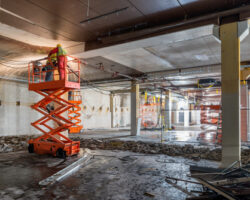Scissor Lift vs. Ladder: Which One Is Best for You?
 Scissor Lift vs. Ladder: Which One Is Best for You?
Scissor Lift vs. Ladder: Which One Is Best for You?
When it comes to working at heights, the decision to use a scissor lift or a ladder will depend on a variety of factors, such as the height and weight requirements, the level of mobility needed, and the type of job being performed. In this blog post, we’ll compare the pros and cons of using a scissor lift versus a ladder and help you figure out which one is best for your needs.
Scissor Lifts
Scissor lifts are a type of aerial work platform that uses a scissor mechanism to raise and lower the platform. They are often used in construction and maintenance settings, where workers need to access height while still being able to move around.
Pros
1. Greater stability: Scissor lifts are known for their stability, making them ideal for tasks that require a secure platform. They can be used in rough terrain and may even able to adjust for slight inclines.
2. Increased height accessibility: A scissor lift can offer greater accessibility to higher elevations than a ladder, while also providing a safer work environment. This is particularly useful in indoor settings, where there may be obstacles that prevent the use of a ladder.
3. Maneuverability: Scissor lifts are designed for easy movement, meaning they can be used in areas with limited space. Their platform can be raised and lowered, and they can be moved forward and backward, making work positioning a breeze.
4. Load capacity: Scissor lifts usually have a higher weight capacity, which means multiple workers or heavier equipment can be safely transported to the work area. This reduces the need for location changes, making work more efficient.
Cons
1. Higher cost: Scissor lifts are more expensive than ladders, which means they may not be practical for smaller jobs that don’t require such equipment. Renting a scissor lift from a reputable equipment rental company can help offset potential costs.
2. Technical issues: Scissor lifts require a level of technical knowledge to operate, including a certain degree of certification, which can add additional costs.
3. Time Limitations: Some scissor lifts are wired, and may require charging from time to time which can cause downtime.
Ladders
Ladders are the most common tool used when working at heights. Whether you’re a DIY enthusiast or a professional worker, a ladder is a key tool to have in your arsenal.
Pros
1. Portability: Ladders are lightweight and easy to transport, making them ideal for jobs that require mobility and flexibility. They come in various sizes and styles to suit a broad range of uses.
2. Cost effectiveness: Compared to scissor lifts, ladders are generally more affordable, making them perfect for smaller projects or smaller businesses.
3. Simplicity: Ladders are easy to use and don’t require any technical knowledge to operate. They can be moved around easily by a single person and typically require little to no maintenance.
Cons
1. Limited height: Ladders have a lower maximum height accessible compared to scissor lifts, and they may not be appropriate for working at high elevations without additional safety precautions being in place.
2. Stability: Ladders can be unstable and prone to tipping over, which can be a significant safety concern. Non-slip padding and stabilizers can be used to reduce this risk.
3. Skill Required: Although operating ladders is easy, climbing requires appropriate skill and experience. If someone does not have the right knowledge and takes unnecessary risks, it can lead to accidents.
Scissor Lift vs. Ladder: Which One is Best for You?
The decision to use a scissor lift or a ladder will, in many cases, depend on the nature of the task and the environment it is performed in. Here are some things to consider before making your decision:
1. Project size and budget: If you are working on a larger project where heights are routinely accessed, a scissor lift may be the best option. However, if you are working on a smaller job that doesn’t require heavy equipment and is on a tight budget, a ladder may suffice.
2. Maneuverability: If you’re working in an area with limited space, a scissor lift may be challenging to operate, especially if there’s a need to change positions frequently. This could make a ladder a better choice.
3. Safety: Different tasks require different safety precautions. If you’re working at great heights and dealing with heavy machinery, a scissor lift is the way to go. However, for basic maintenance tasks, a ladder may be more than effective for the job.
4. Skill: Operating a scissor lift is more complicated than using a ladder, so it requires specialized knowledge and certificates. Ladders, on the other hand, are more straightforward and do not require any special knowledge or certifications beyond basic skills.
Conclusion
Both the scissor lift and the ladder are highly useful tools for working at heights. When deciding which one to use, consider elements such as safety, budget, and ease of use. Take the time to evaluate the job requirements, and make a decision based on the available resources and the safety factors required for the task at hand. By taking these factors into consideration, you can make an informed decision and select the right tool for the job.
